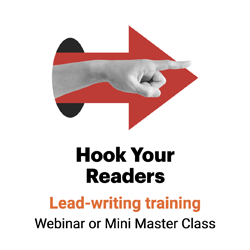The New York Times runs 33% feature leads
New York’s Grey Lady isn’t so gray any more. Topping one-third of its stories with feature leads, The New York Times covers the world in living color.

Feature leads grab attention with concrete, creative, provocative details. In a recent edition, the Times brought 33% stories to life with feature lead approaches including:
1. Description
Description lights up readers’ brains — literally.
Let’s pause and ponder that for a minute too.
For description, go to the scene and observe, using all five of your senses. Then recreate what you’ve experienced on the page, showing readers what they don’t ordinarily see, making them feel what they don’t normally feel.
Description topped the list of The New York Times feature lead approaches, with seven descriptive leads making up 8% of all leads in a recent edition.
Matt A.V. Chaban uses description to start a story about how real estate development has stalled out in North Brooklyn, despite the boom elsewhere in the city.
Instead of Tenants, It’s Cats, Trash and Little Progress for Brooklyn Project
The steel beams rise only six stories, not much for New York, but still they overshadow the neighboring rowhouses and warehouses, as the property-to-be in Brooklyn lunges toward the sky with the silent promise of higher rents.
But beneath the girders and slabs at 55 Eckford Street are a few feet of weeds, littered with beer cans, plastic bags and a forlorn old microwave. Orange safety mesh hangs from the upper floors, like the tattered shroud of some neon ghost. For nearly a decade now, the property on the border between Greenpoint and Williamsburg has barely progressed, going quiet while the last real estate boom was still roaring.
Notice that feature leads aren’t just for feature stories. This lead, for instance, tops a business analysis.
2. Examples, for instances
Lead by example: A pint of “for instances” is worth a gallon of abstraction.
Darth Vader toothbrushes and Pepto-Bismol-slathered schnauzers change the pictures in people’s heads and move readers to act.
Examples came in No. 2 of The New York Times feature lead approaches in a recent edition. Six “for instance” leads made up 7% of all the leads we reviewed.
Ben Sisario uses examples to launch a story about radio’s hottest new format:
Classic Hip-Hop Is Spreading on the Radio Dial
Oldies radio used to mean Johnny Mathis and the Four Seasons. Now it’s Tupac Shakur and LL Cool J.
3. Juicy details
Fun facts and juicy details make your copy more vivid. The New York Times ran five juicy details leads — 5% of all leads — in a recent edition.
Michael Paulson uses juicy details to introduce a story about how local governments are taking an increasingly hard line on religious shop owners who refuse to serve gay customers:
Can’t Have Your Cake, Gays Are Told, and a Rights Battle Rises
LAKEWOOD, Colo. — Jack Phillips is a baker whose evangelical Protestant faith informs his business. There are no Halloween treats in his bakery — he does not see devils and witches as a laughing matter. He will not make erotic-themed pastries — they offend his sense of morality. And he declines cake orders for same sex weddings because he believes Christianity teaches that homosexuality is wrong.
4. Anecdote
When you need to win the hearts and minds of your readers, tell them a story. Anecdote, narrative and other storytelling techniques are the most powerful forms of human communication.
The Times ran four anecdotal leads — 5% of all leads — in a recent edition.
Tatiana Schlossberg and Nina Bernstein use anecdote to start a story about the vulnerability of frail nursing home residents in New York state. There, rates of substandard care, neglect and abuse are high, according to national studies:
Death in Bronx Shows Vulnerability of State’s Nursing Home Residents
Unable to see clearly and afflicted with dementia, Frank Mercado, 77, depended completely on the care provided by the small nursing home in the Bronx where he had lived for four years. But last Monday, as Mr. Mercado cried for help, a veteran employee beat him to the ground, where he was impaled on a sharp metal protrusion from an overturned table, according to prosecutors.
5. Compression of details
For compression of details, you list your most powerful details, squeeze them together in a paragraph, then polish them. Like squeezing together a lump of coal to make a diamond, compression of details condenses fascinating facts into a passage that’s more than the sum of its parts.
The Times ran two compression-of-details leads — 2% of all leads — in a recent edition.
Claire Cain Miller compressed three details to introduce a story about new machines that can handle knowledge and service jobs, as well as factory and clerical work:
As Robots Grow Smarter, American Workers Struggle to Keep Up
A machine that administers sedatives recently began treating patients at a Seattle hospital. At a Silicon Valley hotel, a bellhop robot delivers items to people’s rooms. Last spring, a software algorithm wrote a breaking news article about an earthquake that The Los Angeles Times published.
6. Wordplay
Want to captivate your readers? Get the media to steal your sound bites? Make your message more eloquent and memorable? Wordplay can help.
The Times ran two wordplay leads — that’s 2% of all leads — in a recent edition.
Wordplay includes techniques like alliteration, balance and rhyme. Matthew Goldstein used twist of phrase in this lead for a story about a billionaire investor who managed to fend off a criminal insider trading investigation of himself. Now he’s looking for a former prosecutor and several agents from the Federal Bureau of Investigation to join his new $10 billion investment firm:
Cohen Seeks Law Experts For Fund
Steven A. Cohen beat them, and now he wants them to join him.
7. Metaphor
Human beings have always learned metaphorically: We add to our knowledge by comparing new concepts to those we already understand. Take computers: They have desktops, files, folders, documents and notepads — all analogies for things in offices.
These analogies serve as shortcuts to understanding. So when you want to help your readers understand new, technical or complicated information, metaphor is the answer.
The Times ran two metaphor leads — that’s 2% of all leads — in a recent edition.
Matthew L. Wald used metaphor to launch this story about how hundreds of scientists and engineers are looking at new kinds of nuclear reactors, intended to be safer, cheaper sources of energy worldwide:
Betting on the Need, Scientists Work on Lighter, Cleaner Nuclear Energy
IDAHO FALLS, Idaho — Filled with pits, seams and fissures, the images that Darin J. Tallman examined in a secure laboratory here looked like the surface of Mars. But they were extreme magnifications of slivers of an odd new material — half metal, half ceramic — that tolerates high heat with ease, and that several companies hope might form the basis of a new reactor technology.
8. Human interest
It’s the “Peer Principle of Persuasion”: People connect with people.
Readers find messages more readable, understandable and persuasive when your let a person stand for your point. So find a poster person and use human interest for your leads.
The Times ran one human-interest lead — that’s 1% of all leads — in a recent edition.
Elisabeth Rosenthal used human interest to start this story about how “testing has become to the United States’ medical system what liquor is to the hospitality industry: a profit center with large and often arbitrary markups”:
The Odd Math of Medical Tests: One Scan, Two Prices, Both High
PRINCETON, N.J. — Len Charlap, a retired math professor, has had two outpatient echocardiograms in the past three years that scanned the valves of his heart. The first, performed by a technician at a community hospital near his home here in central New Jersey, lasted less than 30 minutes. The next, at a premier academic medical center in Boston, took three times as long and involved a cardiologist.
Feature features.
Want to grab people’s attention and keep it for the long haul? Take a tip from The New York Times and run more feature stories and feature leads.
What can you steal from the newspaper of record’s approach to starting stories?

Leave a Reply